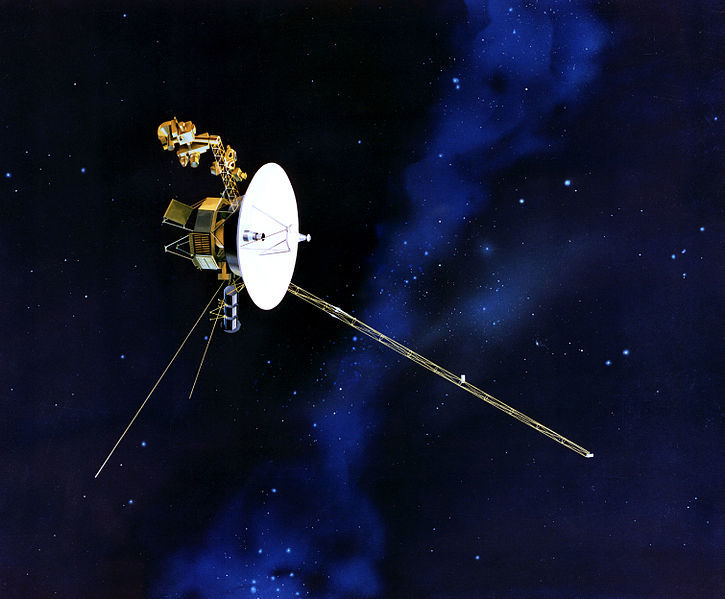Voyage From The Sun
 An artist's rendition of Voyager 1 probe
An artist's rendition of Voyager 1 probe
Since the late 1970's, NASA has launched several probes to explore the outer solar system, including Voyagers 1 & 2, Pioneers 10 & 11, and most recently the New Horizons space probe. Sometime in the future, these probes may effectively escape the gravitational influence of the Sun.
If a probe is launched from rest (relative to the Sun) near Earth (which is a distance of 1 . 5 0 × 1 0 1 1 m from the Sun), how much work per unit mass of the probe must be performed on it, if it is to escape the Sun's gravitational pull eventually?
In your calculation, neglect the influence of nearby smaller bodies, such as Earth. Use the fact that the mass of the Sun is 1 . 9 9 × 1 0 3 0 kg and Newton’s gravitational constant is 6 . 6 7 × 1 0 − 1 1 kg 2 J ⋅ m . Express your answer in tons of TNT per kilogram; the energy equivalent of 1 ton of TNT is 4 . 1 8 × 1 0 9 J . Round your answer to 3 significant digits.
Hint: recall that gravitational escape energy is conventionally defined as the work needed to escape to infinity with no excess kinetic energy.
Image credit: NASA
The answer is 0.212.
This section requires Javascript.
You are seeing this because something didn't load right. We suggest you, (a) try
refreshing the page, (b) enabling javascript if it is disabled on your browser and,
finally, (c)
loading the
non-javascript version of this page
. We're sorry about the hassle.
3 solutions
Exactly what i did nice one !!
Recall the minimum speed needed for a body of mass m to escape a gravitational field of a star or planet of mass M from a distance R i.e. the escape velocity is v e = 2 G M / R where G is the Newton's gravitational constant. So, the minimum amount of work needed is simply the minimum kinetic energy you must provide the body to escape. That is K = 2 1 m v e 2 = 2 1 m R 2 G M = R G M m Hence, work per unit mass is m K = R G M Plugging in the values and dividing by 4 . 1 8 × 1 0 9 J/ton of TNT we get 0 . 2 1 1 6
I found the answer i.e. 0.2124 using another logic. We can integrate the negative of work done per unit mass of probe by moving the probe from near earth to infinity. Plugging the limits and dividing by the TNT Equivalent energy, we get the answer.
In this problem, we are looking for the work W needed to move a mass m from a point R = 1 . 5 0 × 1 0 1 1 m from the Sun to a point very far from the Sun. We assume the mass is initially at rest relative to the Sun, and conventionally, when we consider a gravitational escape, we take the escaped object’s final speed to be 0. Therefore, the statement of conservation of energy reduces to W = Δ U = U f − U 0 since the change in kinetic energy is 0. In other words, the work needed to escape the gravitational influence of the Sun is equal to the object's change in gravitational potential energy.
Furthermore, If we set the zero point of the potential energy at infinity, then U f = 0 and U 0 = − R G m M ⊙ where M ⊙ is the mass of the sun, 1 . 9 9 × 1 0 3 0 kg , and G is Newton’s gravitational constant. Plugging in for U 0 and U f in the energy conservation statement above, we find W = R G m M ⊙ . We can divide both sides by mass of the probe, m , to find work per unit mass: m W = R G M ⊙ .
Now we can insert the given parameters in SI units, and upon converting from Joules to tons of TNT, we find m W = ( 1 . 5 0 × 1 0 1 1 m ) ( 6 . 6 7 × 1 0 − 1 1 kg 2 J ⋅ m ) ( 1 . 9 9 × 1 0 3 0 kg ) × 4 . 1 8 × 1 0 9 J 1 ton of TNT = 0 . 2 1 2 kg tons of TNT .
Since space probes are several hundreds of kilograms, the energy equivalent of several tens of tons of TNT is needed to boost the probe out of the solar system. In practice, this energy is not provided by propulsion, but rather by strategically using the gravity of orbiting planets.